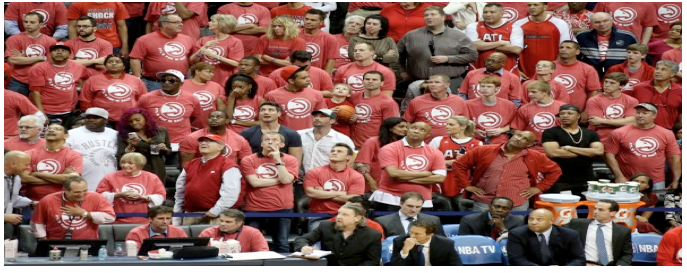IMPERFECT UNION-It’s not surprising that the release of Atlanta Hawks co-owner Bruce Levenson’s racially provocative e-mail about his team’s fan base didn’t inspire the same level of public outrage as the secretly recorded rantings of former Clippers owner Donald Sterling.
The Levenson story lacked the pathos, the sordid sexual angle, the dysfunctional marriage, and the irrational court maneuverings of a man whose own family trust declared him “mentally incapacitated.”
What’s more, as soon as Levenson knew the 2012 e-mail would be released, he apologized for writing “inflammatory nonsense,” and (perhaps inspired by the $2 billion Clippers sales price) agreed to sell his controlling interest in the team.
The Hawks owner’s pre-emptive capitulation deprived us all of the opportunity to engage in yet another all-consuming 24/7 media frenzy in which we could have endlessly chewed over the contents of his infamous e-mail, and their significance.
I am not usually a fan of flooding the zone on the bad behavior of the rich and famous, but this story might have warranted it. Because while it lacks the cartoon-like buffoonery of Donald Sterling’s antics, the Levenson affair tells us a whole lot more about the serious racial challenges facing America today.
If nothing else, Levenson’s e-mail should remind us how old-fashioned racism—the belief in the innate inferiority of members of an entire race—isn’t the only source of racial conflict in America. Levenson didn’t use racist epithets in his e-mail to the team’s general manager. Nor did he articulate a disdain for African-Americans in general. What he did do, however, was express his belief that white fans were uncomfortable being outnumbered by black fans and that, given this assessment, he’d prefer a broader white fan base than a black one.
Did Levenson belittle the importance of African-American basketball fans? Absolutely. But ultimately his comments were about demographics, and the relative status and comfort implicit in being a member of a majority group.
When Americans refer to majority and minority populations, they are generally speaking of the demographics of the nation at large, which has always had a white Protestant majority. But since the founding of the republic, cities, towns, and states across the country have experienced dynamic population shifts that have turned local minorities into majorities and vice versa.
Germans became the majority in Milwaukee in the 1860s. Irish-Americans replaced white Anglo-Saxon Protestants as the majority population in Boston around 1900. By 1980, blacks were the new majority in Baltimore. In 2001, whites became a minority in California. All of these demographic changes created intergroup tensions.
Now, I’m not arguing that ethnicity represents as deep a divide as race in America. The history of black-white relations reveals levels of cruelty and enmity that even the bitterest tensions between Massachusetts WASPs and the Irish never did. But the principle is the same. The relative size of ethnic and racial groups can influence how members of these groups get along with one another.
That’s because in intergroup relations—as in basketball—size matters. The majority status of racial or ethnic groups in any given location carries with it enough benefits to induce competition and tension.
A 2007 study of Illinois residents found that living in a “higher percentage same-race neighborhood” can improve “the emotional well-being” of residents. This research strongly implies that residents of such neighborhoods are seeking emotional as well as economic benefits in togetherness.
Presumably, the racial and ethnic kinship of majority group membership shores up identity, protects against discrimination by non-group members, and provides networks and support.
Similarly, a 2004 study out of Germany found that, particularly in the Western world, minority and majority memberships have “distinct effects on a variety of important social psychological phenomena.”
Most importantly, newfound minority status can create “a state of uneasy mindfulness” in individuals because they are suddenly more aware of their group identity. Majority members “can take their existence for granted,” the German study concluded—and as a result, “they tend to forget their identity (without losing it).”
{module [862]}
{module [662]}
Minority members, however, can feel obliged to expend greater amounts of emotional energy asserting their identities and making space for themselves in the world.
Perhaps because Levenson himself is Jewish, he seems to implicitly understand the burdens of being in the minority. His e-mail states explicitly that he thinks Southern whites “simply were not comfortable being in an arena or at a bar where they were in the minority.”
But rather than find ways to make both groups—and ideally others—feel welcome and included in the culture of Hawks fandom, he sided with whites, in part because he had already concluded, as he wrote in the damning e-mail, that “there are simply not enough affluent blacks to build a significant season ticket base.”
The facts of the Levenson affair are very much specific to the universe of basketball fans in Atlanta, Georgia. But because demographers keep telling us that Anglos are projected to become a minority in the United States sometime around 2043, there is a broader, more far-reaching cautionary tale here.
Over the next several decades, how will whites react to losing their majority status in cities and counties across the country? How will prominent business owners and politicians seek to ease possible tensions? Will their long tenure as the historic majority make whites’ transition to minority status all the more difficult?
No, Levenson’s e-mail won’t get the same attention as Donald Sterling’s pathetic rants. But its content and twisted logic speak to a far more endemic problem facing a rapidly changing America.
(Gregory Rodriguez is the founder and publisher of Zócalo Public Square … where this column was first posted. Zocalo Public Square … connecting people and ideas.)
-cw
CityWatch
Vol 12 Issue 76
Pub: Sep 19, 2014





